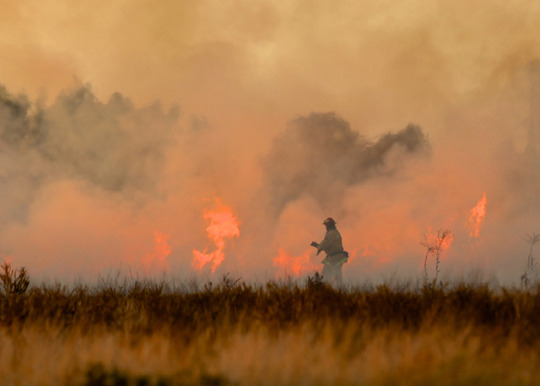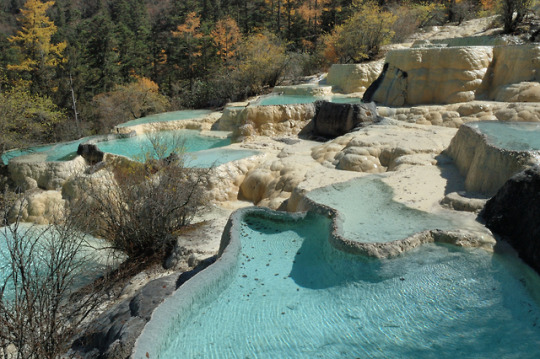#psuenvironmentalscienceandmanagement
Photo

Angela Strecker, Associate Professor of Environmental Science and Management, co-authored an article titled, “Nutrients mediate the effects of temperature on methylmercury concentrations in freshwater zooplankton”, published in Science of the Total Environment in 2019.
Methylmercury (MeHg) bioaccumulation in freshwater aquatic systems is impacted by anthropogenic stressors, including climate change and nutrient enrichment. The goal of this study was to determine how warmer water temperatures and excess nutrients would alter zooplankton communities and phytoplankton concentrations, and whether those changes would in turn increase or decrease MeHg concentrations in freshwater zooplankton. To test this, we employed a 2 × 2 factorial experimental design with nutrient and temperature treatments. Mesocosms were filled with ambient water and plankton from Cottage Grove Reservoir, Oregon, U.S.A., a waterbody that has experienced decades of elevated MeHg concentrations and corresponding fish consumption advisories due to run-off from Black Butte Mine tailings, located within the watershed. Treatment combinations of warmer temperature (increased by 0.7 °C) and nutrient addition (a single pulse of 10× ambient concentrations of nitrogen and phosphorous), control, and a combination of temperature and nutrients were applied to mesocosms. The individual treatments altered phytoplankton densities and community structure, but alone the effects on MeHg concentrations were muted. Importantly, we found a significant interactive effect of nutrients and temperature: the nutrient addition appeared to buffer against increased MeHg concentrations associated with elevated temperature. However, there was variability in this response, which seems to be related to the abundance of Daphnia and edible phytoplankton. Nutrients at low temperature were associated with marginal increases (1.1×) in zooplankton MeHg. Our findings suggest that global change drivers that influence community composition and ecosystem energetics of both zooplankton and phytoplankton can alter MeHg pathways through food webs.
0 notes
Photo

David Ervin, Environmental Management and Economics emeritus faculty and Sustainable Solutions fellow, co-authored “Farmer Attitudes Toward Cooperative Approaches to Herbicide Resistance Management: A Common Pool Ecosystem Service Challenge,” published in Ecological Economics, Vol. 157, pp. 237-245, March 2019.
Dramatic growth in herbicide-resistant (HR) weeds in the United States threatens farm profitability and may undercut environmentally beneficial farming practices. When HR weeds move across farm boundaries due to ecological processes or human action, a common pool resource challenge emerges, requiring farmer cooperation to manage such weeds effectively. We investigate the scope for cooperative management using responses to a national survey on HR weed issues to test a recursive model of three preconditions for collective action: (1) concern about HR weeds migrating from nearby lands; (2) communication with neighbors about HR weeds; and (3) belief that cooperation is necessary for effective resistance management. Results suggest that farmers who relied more on Extension educators regarding weed management, were more likely to satisfy each precondition. Further, concern about weeds resistant to multiple herbicides as well as concern about HR weed mobility positively influence concern about migration and views toward cooperation. Farmer time constraints and “techno-optimism” (a belief that herbicide discoveries will solve resistance problems) detract from the perceived need for cooperative approaches. A different set of factors significantly affect each precondition, suggesting heterogeneity in the underlying casual mechanisms. The findings can help tailor collective action to different socio-ecological settings experiencing HR weed resistance issues.
0 notes
Photo

Angela Strecker, Environmental Science and Management faculty, co-authored “Macroecological Drivers of Zooplankton Communities Across the Mountains of Western North America” in press with Ecography.
Disentangling the environmental and spatial drivers of biological communities across large scales increasingly challenges modern ecology in a rapidly changing world. Here, we investigate the hierarchical and trait‐based organization of regional and local factors of zooplankton communities at a macroscale of 1240 mountain lakes and ponds spanning western North America (California, USA, to Yukon Territory, Canada). Variation partitioning was used to test the hypothesized importance of climate, connectivity, catchment features, and exotic sportfish to zooplankton beta‐diversity in the context of key functional traits (body size and reproductive dispersal potential) given the pronounced environmental heterogeneity (e.g. thermal gradients), topographic barriers, and legacy of stocked fish in mountainous regions. Dispersal limitation was inferred from multispecies patch connectivity estimates based on nearest and average distances to occupied patches. Environmental heterogeneity best explained community composition as catchment/lake features (morphometry, land cover, and lithology) collectively captured greater variation than did climate (temperature, precipitation, and solar radiation), local stocking, or connectivity; however, single climatic variables captured the most variation individually. Macrospatial variation by larger obligate sexual species was better explained than that by smaller cyclically parthenogenetic asexual species. Our results provide several novel insights into the macroecology of zooplankton of the North American Cordillera, demonstrating their stronger associations to climatically driven aquatic‐terrestrial habitat coupling than dynamics arising from introduced salmonids, human land‐use, or species dispersal. These findings highlight the clear and important role of these communities as bioindicators of the limnological impacts of accelerating rates of climate change, as their responses appear relatively not confounded by local human perturbations or dispersal limitation.
0 notes
Photo

Max Nielsen-Pincus, Environmental Science and Management faculty; student Cody Evers; and others co-authored “Archetypes of Community Wildfire Exposure from National Forests in the Western U.S.,” published in Landscape and Urban Planning, Vol. 182, pp. 55-66.
Risk management typologies and their resulting archetypes can structure the many social and biophysical drivers of community wildfire risk into a set number of strategies to build community resilience. Existing typologies omit key factors that determine the scale and mechanism by which exposure from large wildfires occur. These factors are particularly important for land managing agencies like the US Forest Service, which must weigh community wildfire exposure against other management priorities. We analyze community wildfire exposure from national forests by associating conditions that affect exposure in the areas where wildfires ignite to conditions where exposure likely occurs. Linking source and exposure areas defines the scale at which cross-boundary exposure from large wildfires occurs and the scale at which mitigation actions need to be planned. We find that the vast majority of wildfire exposure from national forests is concentrated among a fraction of communities that are geographically clustered in discrete pockets. Among these communities, exposure varies primarily based on development patterns and vegetation gradients and secondarily based on social and ecological management constraints. We describe five community exposure archetypes along with their associated risk mitigation strategies. Only some archetypes have conditions that support hazardous fuels programs. Others have conditions where managing community exposure through vegetation management is unlikely to suffice. These archetypes reflect the diversity of development patterns, vegetation types, associated fuels, and management constraints that exist in the western US and provide a framework to guide public investments that improve management of wildfire risk within threatened communities and on the public lands that transmit fires to them.
#PSUResearch#portlandstateresearch#PortlandStateUniversity#psuclas#psuenvironmentalscienceandmanagement
0 notes
Photo

Shawna Vreeke (graduate student, chemistry), Tetiana Korzun (graduate student, biology), Wentai Luo (Civil & Environmental Engineering), Paul Jensen (graduate student, chemistry), David Peyton and Robert Strongin (Chemistry) co authored “Dihydroxyacetone Levels in Electronic Cigarettes: Wick Temperature and Toxin Formation,” published in the January 2018 issue of Aerosol Science and Technology.
Abstract
Recently, we reported the presence of dihydroxyacetone (DHA), the active ingredient in sunless tanners, in the aerosol of an electronic cigarette. DHA has been shown to react with DNA in vitro. The FDA restricts the use of DHA to external application only. It states that it should not be inhaled, ingested or come into contact with any areas containing mucous membranes, due to unknown risk. Herein, the quantification of DHA in the aerosols of three brands of e-cigarettes has been carried out. These included two devices with horizontal heating coil configurations as well as one with a sub-ohm resistance vertical heating coil. In order to understand and begin to address the origin of DHA and related aerosol products, the wicking properties of the three e-cigarettes were compared. DHA levels were analyzed by a combination of GS/MS and 1░H-NMR. DHA was found in all three e-cigarettes, with substantially less in the sub-ohm, vertical coil device as compared to the horizontal coil devices (e.g., 0.088░µg/puff vs 2.29░µg/puff, respectively). Correspondingly, the temperature of the wet layer of the wick for the vertical coil was relatively stable, compared to the wicks for the horizontal coils, upon increasing battery power output. This result is in agreement with prior studies of e-cigarette wicking efficiency and aerosol toxin formation. The temperature measurements reported are a simple means for comparing devices with different design properties during operation.
#portland state university#portlandstateresearch#psuresearch#psuclas#psubiology#psumcecs#psuenvironmentalscienceandmanagement
0 notes
Photo

Marion Dresner, Environmental Science and Management faculty member, coauthored “Gardening for Wildlife: Tree canopy and small-scale planting influences on arthropod and bird abundance,” published on Cities and the Environment.
This paper describes the results of several years of study of backyards in Portland that have been restored as backyard habitats. We measured the relative success of yard habitats in contributing to diversity and abundance of forest-habitat birds. We studied how the abundance and diversity of shrubs, arthropods, and birds were related. We compared two neighborhoods; one having high, native tree cover, and the second having lower, non-native tree cover. Both the amount of regional and local tree cover had a stronger statistical signal than shrub cover. The presence of native species of shrubs in these yards was not a good predictor for abundance of arthropods.
#portland state university#portlandstateresearch#psuresearch#psuclas#psuenvironmentalscienceandmanagement#psusustainability
0 notes
Photo

Elise Granek and Catherine de Rivera, Environmental Science and Management faculty coauthored “Prozac in the water: Chronic fluoxetine exposure and predation risk interact to shape behaviors in an estuarine crab,” published in Ecology and Evolution, September 2017, DOI: 10.1002/ece3.3453
Abstract: Predators exert considerable top-down pressure on ecosystems by directly consuming prey or indirectly influencing their foraging behaviors and habitat use. Prey is, therefore, forced to balance predation risk with resource reward. A growing list of anthropogenic stressors such as rising temperatures and ocean acidification has been shown to influence prey risk behaviors and subsequently alter important ecosystem processes. Yet, limited attention has been paid to the effects of chronic pharmaceutical exposure on risk behavior or as an ecological stressor, despite widespread detection and persistence of these contaminants in aquatic environments. In the laboratory, we simulated estuarine conditions of the shore crab, Hemigrapsus oregonensis, and investigated whether chronic exposure (60 days) to field-detected concentrations (0, 3, and 30 ng/L) of the antidepressant fluoxetine affected diurnal and nocturnal risk behaviors in the presence of a predator, Cancer productus. We found that exposure to fluoxetine influenced both diurnal and nocturnal prey risk behaviors by increasing foraging and locomotor activity in the presence of predators, particularly during the day when these crabs normally stay hidden. Crabs exposed to fluoxetine were also more aggressive, with a higher frequency of agonistic interactions and increased mortality due to conflicts with conspecifics. These results suggest that exposure to field-detected concentrations of fluoxetine may alter the trade-off between resource acquisition and predation risk among crabs in estuaries. This fills an important data gap, highlighting how intra- and interspecific behaviors are altered by exposure to field concentrations of pharmaceuticals; such data more explicitly identify potential ecological impacts of emerging contaminants on aquatic ecosystems and can aid water quality management.
Prozac in the water: Chronic fluoxetine exposure and predation risk interact to shape behaviors in an estuarine crab. Available from: https://www.researchgate.net/publication/320133543_Prozac_in_the_water_Chronic_fluoxetine_exposure_and_predation_risk_interact_to_shape_behaviors_in_an_estuarine_crab [accessed Oct 4, 2017].
#portland state university#portlandstateresearch#psuresearch#psuclas#psuenvironmentalscienceandmanagement
0 notes
Photo

Gregory Ruiz, Environmental Science and Management affiliate, recently coauthored “Tsunami-driven rafting: Transoceanic species dispersal and implications for marine biogeography,” published in Science. The study was featured by the BBC News: http://www.bbc.com/news/science-environment-41427691
Abstract: The 2011 East Japan earthquake generated a massive tsunami that launched an extraordinary transoceanic biological rafting event with no known historical precedent. We document 289 living Japanese coastal marine species from 16 phyla transported over 6 years on objects that traveled thousands of kilometers across the Pacific Ocean to the shores of North America and Hawai‘i. Most of this dispersal occurred on nonbiodegradable objects, resulting in the longest documented transoceanic survival and dispersal of coastal species by rafting. Expanding shoreline infrastructure has increased global sources of plastic materials available for biotic colonization and also interacts with climate change–induced storms of increasing severity to eject debris into the oceans. In turn, increased ocean rafting may intensify species invasions.
#portland state university#portlandstateresearch#psuresearch#psuclas#psuenvironmentalscienceandmanagement
0 notes
Text
With funding from Oregon Sea Grant, PSU marine ecologist Elise Granek and master's student Britta Baechler are studying the amounts and types of microplastics in razor clams and oysters along the Oregon coast. These extremely small plastics can come from foams, tiny beads in facial creams, fibers from clothing, and disintegrating plastic bags. The researchers aim to see if there are specific places on the coast where microplastics are more prevalent and if their presence is more common during certain times of the year.
youtube
#portland state university#portlandstateresearch#psuresearch#psuclas#psuenvironmentalscienceandmanagement#psusustainability
0 notes
Photo

New NSF grant to study fire and climate change in Alaska
Dr. Melissa Lucash, Research Assistant Professor, Geography, recently received a $1.4 million grant from the National Science Foundation (Office of Polar Programs, Arctic Natural Resources) for the project “Regional Impacts of Increasing Fire Frequency on Carbon Dynamics and Species Composition in the Boreal forest.” As the lead of the grant, she will coordinate with Drs. Vladimir Romanovsky (U. Alaska Fairbanks), Brian Buma (U. Alaska Southeast), Dr. Jason Vogel (U. Florida), and Tim Link (U. Idaho) to quantify the potential for large-scale changes in carbon cycling and vegetation in boreal forests due to climate change and repeated wildfires by integrating field and lab work with landscape modeling. Working in central Alaska, the investigators will: 1) determine how fire frequency and climate change affect species composition and above- and below-ground C cycling, and 2) assess how the mechanisms that cause tipping points between vegetation types (i.e. conifer, hardwood, grasses) and C sequestration (i.e. C sink vs. C source) vary with space and time. The study will train graduate students and involve Native American high school students from the Rural Alaska Honors Institute (RAHI) in field work. The investigators will collaborate with Your World Rocks (YWR), a nonprofit organization of female scientists and engineers dedicated to promoting science education in elementary schools, to conduct free hands-on activities in elementary schools in the greater Portland/Vancouver metro area.
#portland state university#portlandstateresearch#psuresearch#psuclas#psugeography#psusustainability#psusubmission#psuenvironmentalscienceandmanagement
0 notes
Photo

Max Nielsen-Pincus, Environmental Science and Management faculty, coauthored “Choosing the Right Policy Tools to Encourage Watershed Stewardship through the Study of Attitude,” published in Society and Natural Resources · August 2017DOI: 10.1080/08941920.2017.1347973
Abstract: Recently, a number of “Payment for Watershed Services” programs have aimed to engage private landowners in watershed stewardship initiatives by offering financial incentives for adopting watershed best management practices. However, a growing field of research suggests that financial incentives alone may be of limited utility to encourage widespread and long-standing behavior change, and other policy tools may be required. This research examines how attitudes may influence enrollment in watershed stewardship programs to shed light the application of incentive, capacity building, and symbolic policy tools. We distributed a questionnaire to rural landowners in the Clackamas River watershed, OR, and received 281 valid responses (29% response rate). We found that attitudes associated with trust, ecological understanding, and technical capacity played more fundamental roles compared with financial considerations. We interpret these findings by evaluating the likely efficacy of various policy tools, and stress the importance of engaging landowners by building capacity and trust.
#portland state university#portlandstateresearch#psuresearch#psuclas#psuenvironmentalscienceandmanagement#psusustainability
0 notes
Photo

Yangdong Pan, environmental science and management faculty member, co-authored “Detecting early signs of environmental degradation in protected areas: An example of Jiuzhaigou Nature Reserve, China,” published in the August 2018 issue of Ecological Indicators. The article presents findings from a study in which Jiuzhaigou Nature Reserve was used as an example study to overcome the challenges of assessing human-caused disturbances to aquatic systems. The research team developed an approach that integrated human activities known to impact aquatic systems to create an index for assessing how that activity impacts aquatic ecosystems in the reserve.
Abstract
Identifying early signs of anthropogenic disturbances in protected areas is critical for determining overuse, safeguarding natural beauty, protecting biodiversity, and sustaining resource use and economy. Assessing disturbances to aquatic systems of such areas is challenging due to the low-dose, diffused, and cumulative nature of disturbances; high risk at iconic sites; and difficulty of linking human activities with degradation. Using Jiuzhaigou Nature Reserve as an example study to overcome such challenges, we developed an approach that integrated human activities known to impact aquatic systems to calculate a holistic disturbance index for assessing the extent of human uses at scales of entire reserve and individual sub-watersheds. We linked human disturbance index with benthic algae and macroinvertebrate indicators of individual waterbodies to identify early signs of degradation. We conducted in situ nutrient experiments and intensive sampling of biota at iconic sites with early signs of degradation to provide direct linkage between tourist activities and eutrophication, and to pinpoint mechanisms of how human disturbances have resulted in such degradations. We found that the human disturbance index significantly correlated with benthic algae and macroinvertebrate indicators, and Jiuzhaigou is largely in healthy condition. For the two identified iconic sites with early signs of degradation, intensive tourist activities at observation and rest areas of Five-Color Lake seemed to link to extra amount of nitrogen input into the lake and resulted in overgrowth of phytoplankton and filamentous algae during summer peak tourist months. Extra amount of phosphorus input from tourism activities at Pearl Shoal seemed the cause of changes in substrate colors and of shifts in attached moss and algal communities. Our example study demonstrates that early signs of degradation can be visually observed and should be further assessed by measuring water quality and sensitive biological indicators at high risk areas of a waterbody during summer and peak tourist seasons. Sensitive biological indicators (e.g., intolerant diatom and macroinvertebrates) are better indicators than nutrient concentrations because of rapid assimilation of nutrients by algae and macrophytes. Our assessment approach and findings of studying Jiuzhaigou have broad applications to other protected areas for determining overuse, and hence for making science-based policy and taking adequate management actions to prevent overuses.
#portland state university#portlandstateresearch#psuresearch#psuclas#psuenvironmentalscienceandmanagement
0 notes